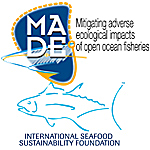All around the world there has been increasing concern about the deterioration of shark's population status due to a very high fishing effort on tuna stocks and consequently on sharks caught as by-catch. Our contribution to reduce the impact on these species was to identify nursery areas for two relevant species in the Southwestern Atlantic Ocean: blue (Prionace glauca) and oceanic whitetip (Carcharhinus longimanus) sharks. Size, catch and effort data was collected by on-board observers of the National Observer Program that surveyed the Brazilian chartered tuna longline fleet from 2005 to 2010. The spatial distribution of juveniles was predicted using the catch rates CPUEs (Capture per Unit of Effort). Juveniles were defined using the length at first maturity obtained from previous studies as criteria (blues shark: 226 cm total length, oceanic whitetip shark: 180 cm). A general additive model was then applied, with the CPUE as the response variable. Latitude, longitude and fishing strategy (factor that represents the fishing operation) were considered as the explanatory variables. A very clear pattern was observed for the blue shark with the CPUE increasing southwards and peaking in the area bounded by 18° to 28° S of latitude and 36° to 26° W of longitude. For the oceanic whitetip shark, the GAM identified two potential nursery areas, one just above the equator and another between the latitudes of 10° and 15° S.
- Presentation

 PDF version
PDF version
